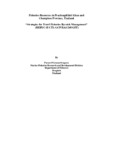Fisheries Resources in PrachuapKhiri Khan and Chumphon Province, Thailand
นามธรรม
From June 2013 - May 2014, a study of fisheries resources and commercial trawlers operating in the locality of Prachuap Khiri Khan and Chumphon Provinces was conducted by collecting data from small-sized otter board trawls (<14 m overall length; OBT1), medium-sized otter board trawls (14 – 18 m overall length; OBT2) and pair trawls (PT).Catch data were also collected from landing sites at Prachuap Khiri Khan and Chumphon fishing ports The results show that catch per unit effort (CPUE) for OBT1, OBT2 and PT were48kg, 28kg and 150kg, per hour respectively. The proportions of food fish and trash fish in the catch were calculated as 36:64%, 58:42%. In the food fish group, demersal fish along withs shrimp and prawn were the main components of the OBT1accounting for86% of the total ‘food fish’ catch Demersal fish and cephalopods were the main components of OBT2accounting for77%of the total food fish catch and pelagic and demersal fish were the main components of PT accounting for83% of the total food fish catch Juveniles of economically important species were found in high percentages of 78%, 64% and 74% respectively in the trash fish catches from these trawlers. The sizes of the economically important species were analyzed and it was found that the mean lengths of most species were smaller than their predicted size at first maturity, particularly for pelagic and demersal species. Length analysis also showed that most individuals of the economically important species caught were smaller than their size at first maturity. Lizardfishes, purple-spotted bigeye, lattice monocle bream and short mackerel were the main species of concern, in terms of the numbers of undersized fish caught. However, length analysis of squid showed a high percentage of individuals at a mature size. Unless adequate management measures are introduced effectively, the present situation of unsustainable harvesting of fisheries resources from trawlers will continue, leading to further declines in fish catches and fish catch quality.
การอ้างอิง
Noranarttragoon, P. (2014). Fisheries Resources in PrachuapKhiri Khan and. Strategies for Trawl Fisheries Bycatch Management, 40.
เรื่อง
คอลเลกชัน
- Country Activities [95]

